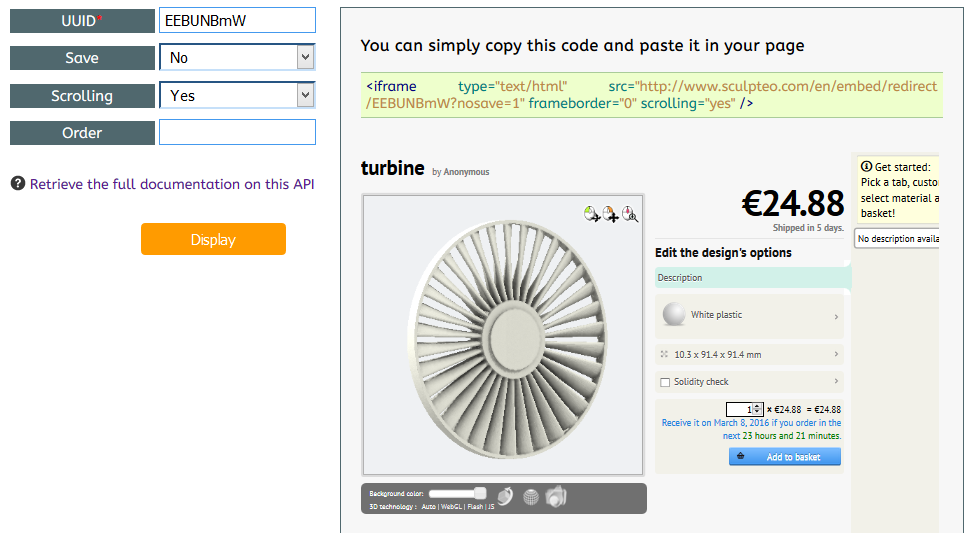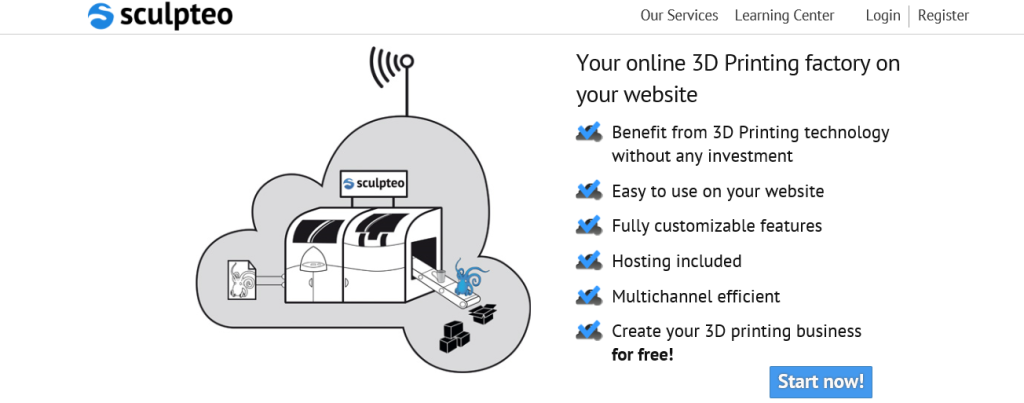Sculpteo’s New Platform Allows Its Website Features to Be Easily Integrated With Your Website
 Let’s talk user-friendly coding for a moment, shall we? An Application Programming Interface (API) refers to a software-to-software interface (not a user interface) that allow applications to connect without user knowledge — providing the necessary coding to expand applications. That being established, Sculpteo has announced that it has 15 different APIs that allow integration with 3D printing business websites. If you think this sounds too complicated and it is best left to a computer programming expert, think again. Sculpteo has released a new API testing platform that is intended to be user-friendly — for you — and financial incentives are also included if your business chooses this route.
Let’s talk user-friendly coding for a moment, shall we? An Application Programming Interface (API) refers to a software-to-software interface (not a user interface) that allow applications to connect without user knowledge — providing the necessary coding to expand applications. That being established, Sculpteo has announced that it has 15 different APIs that allow integration with 3D printing business websites. If you think this sounds too complicated and it is best left to a computer programming expert, think again. Sculpteo has released a new API testing platform that is intended to be user-friendly — for you — and financial incentives are also included if your business chooses this route.
This entire service from Sculpteo revolves around a Cloud Engine that allows users to integrate Scupteo’s website features onto their own sites. API functionality needs to be as versatile as the various kinds of groups who would like to link to Sculpteo’s features: 3D printing user groups, marketplaces, designers, and other businesses and services. For example:
“Let’s say that you’ve invented a 3D scanning or 3D modeling app, and you’d like all the designs you created to be directly uploaded on your Sculpteo’s account. We have an API for that; use our ‘Upload API’ it has two different modes, namely the direct upload and the web to web upload. If you’ve created your own marketplace and you’d like to integrate galleries and 3D previews of the designs in your library, we have an API for that, our ‘Display APIs’ were created for this purpose.”
Get the idea? Beginning on March 1, 2016, Sculpteo’s API test platform allows you to directly copy and paste the programming code displayed on the test platform into your own HTML page code. Just to give you an idea of how this copying and pasting of code works: have you ever wanted to put a YouTube video up on your own website or blog? On the page, you click on the arrow under the video that reads “Share” and you scroll down to “Embed” right beneath it. You copy that code (all those seemingly jumbled numbers,letters, etc.) onto your website and presto! Your video will appear there. If you use WordPress, for example, you would switch from the “Visual” tab to the “Text” tab and then copy the code where you want the video to appear. When you switch back to the “Visual” tab — you will see the video there. It’s really quite simple. We’ve come a long way from those expert coding days that kept many of us less coding-inclined people from having our own awesome websites. (If I understand this, then you can too!)
There are certainly more details depending on which API you are interested in using, but a quick look at the test platform shows you how it works in a few clicks. And Sculpteo offers incentives for you to check out and learn the new API test platform as well:
“By coupling a display API with our affiliation program you’ll earn 7% of sales on our website coming from your website.
By becoming our partner and using our Order API, you’ll be able to generate your own customized packing slip to ship the parcels directly to the customer reducing the shipping costs. You’ll also save time because order will be automatically made and as far as you generate a high-volume of sales, you can save money up to 20% of sales price.”
As Sculpteo reassures its current and future users: “Don’t worry, be API.” Discuss in the 3D API forum over at 3DPB.com.
Subscribe to Our Email Newsletter
Stay up-to-date on all the latest news from the 3D printing industry and receive information and offers from third party vendors.
Print Services
You May Also Like
3D Printing Financials: Prodways Ends 2024 with a Profit
After a tough couple of years, Prodways (EPA: PWG) is starting to bounce back. The French 3D printing company finally made a profit in 2024, improved its operating performance, and...
Blue Origin & Auburn University Use EOS M290 to Study Copper 3D Printing
Blue Origin, the commercial space company built off of investments from Amazon founder Jeff Bezos, has donated two EOS M290 powder bed fusion (PBF) printers to Auburn University’s National Center...
Rocket Lab to Acquire Restructured Laser Communications Provider Mynaric AG
Rocket Lab USA, the Long Beach-based, end-to-end space services company that specializes in producing rockets with additive manufacturing (AM), has announced plans to acquire Mynaric AG, a German provider laser...
3D Printing Financials: Stratasys Ends 2024 with Cost Cuts and Growth Plans
Stratasys (Nasdaq: SSYS) has wrapped up 2024 with stronger margins but a full-year net loss. The polymer 3D printing leader navigated a year of economic headwinds, restructuring efforts, and shifting...





























